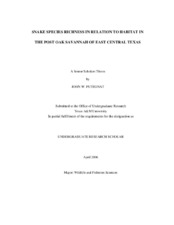| dc.description.abstract | This project examined snake species richness and relative abundances in a heterogeneous landscape within the post oak savannah of East Central Texas. Snakes were sampled using funnel traps (with drift fences for terrestrial species) and hand capture from April to August of 2005 at a 1295 hectare ranch managed for wildlife habitat. Ten sites were sampled within the following habitat categories: upland woodland, prairie, riparian forest, and ponds. A total of 184 individuals of 15 species were observed or captured. The most abundant species were the plain-bellied water snake (Nerodia erythrogaster), western ribbon snake (Thamnophis proximus), and eastern coachwhip (Masticophis flagellum). The least abundant species were the brown snake (Storeria dekayi), speckled kingsnake (Lampropeltis getula), and eastern coral snake (Micrurus fulvius). The timber rattlesnake (Crotalus horridus), a threatened species, appears to have a viable population within the study area. Abundance and species richness varied according to each habitat, with riparian forest having highest collective abundance and species richness, and pond habitats yielding fewest individuals and species. | en |


